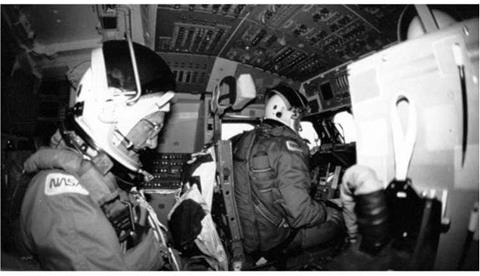STS-29
|
Int. Designation |
1989-021A |
|
Launched |
13 March 1989 |
|
Launch Site |
Pad 39B, Kennedy Space Center, Florida |
|
Landed |
18 March 1989 |
|
Landing Site |
Runway 22, Edwards Air Force Base, California |
|
Launch Vehicle |
OV-103 Discovery/ET-36/SRB BI-031/SSME #1 2031; |
|
#2 2022; #3 2028 |
|
|
Duration |
4 days 23 hrs 38 min 50 sec |
|
Callsign |
Discovery |
|
Objective |
TDRS-D deployment mission |
Flight Crew
COATS, Michael Lloyd, 43, USN, commander, 2nd mission Previous mission: STS 41-D (1984)
BLAHA, John Elmer, 46, USAF, pilot SPRINGER, Robert Clyde, 46, USMC, mission specialist 1 BUCHLI, James Frederick, 43, USMC, mission specialist 2, 3rd mission Previous missions: STS 51-C (1985); STS 61-A (1985)
BAGIAN, James Philip, 37, civilian, mission specialist 3
Flight Log
With the Shuttle up and rolling again, it did not take NASA long to establish an ambitious launch schedule for 1989, which would see seven launches starting with STS-29 on 14 February. The mission was soon put back to 23 February and was delayed again to at least mid-March. As a precautionary measure, the high-pressure oxidiser turbopumps on all three SSMEs on Discovery – by now already on Pad 39B – were replaced because stress corrosion cracks had been discovered on an SSME used for STS-27.
There was concern that the delay might cancel the mission altogether because STS-30 Atlantis needed to be on the pad by 23 March to meet the first day of its planetary launch window for the Magellan spacecraft. The work was completed satisfactorily and a date of 11 March set. Then a master events computer failure caused another delay to 13 March. It did not look too hopeful on this day either, as Discovery and the launch pad were draped in ground fog and there were concerns about conditions on the Kennedy runway should there be a return to launch site abort.
The count proceeded and was held at T — 9 minutes for 1 hour 50 minutes before Discovery rose majestically into the bright sunlit skies at 09: 57hrs local time – accompanied by the first female launch commentary of a US manned launch by NASA’s Lisa Malone – into its 28.45° inclination orbit which would reach a maximum
|
This view of the flight deck of Atlantis shows MS2 Buchli (left) and commander Coats (centre) at work. Pilot Blaha is hidden from view by his seat (right) |
altitude of 283 km (176 miles). For the first time, photographs were captured of the external tank, looking like a fat cigar before being stubbed out during re-entry. In space at last were the original crew of STS 61-H, which was to have flown in June 1986 carrying Britain’s would-be first man in space, Sq. Ldr. Nigel Wood, had it not been for the Challenger disaster. The only newcomer to the crew was James Bagian who replaced Anna Fisher from the original 61-H mission.
At T + 6 hours 13 minutes, the primary payload of the mission, TDRS-D, was deployed, while concerns were raised about pressure surges in the fuel cells of the orbiter. The rest of the mission went swimmingly, concentrating on an array of science experiments and photography using the large format IMAX camera. The weather was so smooth at Edwards Air Force Base that a proposed crosswind landing test could not be performed, so commander Mike Coats aimed for runway 22 and a braking test on the concrete. Mission time was T + 4 days 23 hours 38 minutes 52 seconds. Discovery was in great shape and STS-29 proved to be one of the smoothest missions ever.
Milestones
124th manned space flight 58th US manned space flight 28th Shuttle mission 8th flight of Discovery 4th TDRS deployment mission











